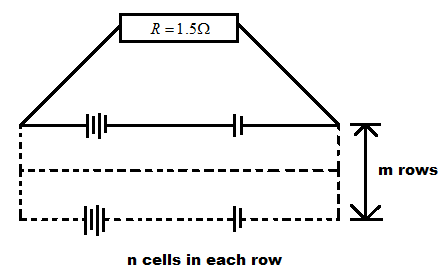
12 cells, each of emf $1.5{\text{V}}$ and internal resistance $0.5\Omega $.are arranged in ${\text{m}}$ rows each containing $'{\text{n'}}$ cells connected in series, as shown. Calculate the values of $'{\text{n'}}$ and ${\text{'m'}}$ for which this combination would send maximum current through an external resistance of $1.5\Omega $.

Answer
220.5k+ views
Hint: In this question, we are having $12$ cells and each cell is having $15{\text{V}}$emf. There are ${\text{m}}$ number of rows and each row is having ${\text{n}}$ cells in each row that are connected in the series. The load resistance is equal to $1.5\Omega $. First, we find the ${R_{{\text{internal}}}}$ by using the resistance in series and parallel formulas and putting it into load resistance and find the value of ${\text{n}}$ and ${\text{m}}$.
Formula used:
Resistance in the series is written as;
${R_s} = {R_1} + {R_2} + .......$
Resistance in parallel is written as;
$\dfrac{1}{{{R_p}}} = \dfrac{1}{{{R_1}}} + \dfrac{1}{{{R_2}}} + ......$
Complete step by step solution:
Here we can write the load resistance as;
${R_{{\text{load}}}} = {R_{{\text{internal}}}} - - - - (1)$
Now here we are having ${\text{n}}$ number of resistances in series so we can write it as,
${R_s} = nr$
Here we take $r$ for resistance in series because we are not getting any confusion.
And we have ${\text{m}}$ a number of resistance parallel formation.
Therefore, we can write internal resistance as,
${R_{{\text{internal}}}} = \dfrac{{{\text{n}}r}}{{\text{m}}}$
Now put this value in the equation $(1)$ we get;
${R_{{\text{load}}}} = \dfrac{{{\text{n}}r}}{{\text{m}}} - - - - (2)$
Here we have, $r = 0.5\Omega ,{R_{{\text{load}}}} = 1.5\Omega $, putting these values in the equation $(2)$ we get;
$1.5 = \dfrac{{\text{n}}}{{\text{m}}} \times 0.5 \\
\Rightarrow \dfrac{{\text{n}}}{{\text{m}}} = \dfrac{{1.5}}{{0.5}} \\
\Rightarrow \dfrac{{\text{n}}}{{\text{m}}} = 3 - - - - (3) \\
$
Now, we have total cells is,
$
{\text{n}} \times {\text{m = }}12 \\
\Rightarrow {\text{nm = }}12 - - - (4) \\
$
Dividing equation $(3)$ by the equation $(4)$ we get;
$
\dfrac{{\text{n}}}{{{\text{n}}{{\text{m}}^2}}} = \dfrac{3}{{12}} \\
\Rightarrow \dfrac{1}{{{{\text{m}}^2}}} = \dfrac{1}{4} \\
\Rightarrow {{\text{m}}^2} = 4 \\
\Rightarrow {\text{m = 2}} \\
$
Now, put this value of ${\text{m}}$ in the equation $(4)$ we get;
$
{\text{nm = 12}} \\
\Rightarrow {\text{n = }}\dfrac{{12}}{2} \\
\Rightarrow {\text{n = 6}} $
Hence there are $6$ cells in series and $2$ cells are parallel.
Hence, the value of ${\text{n = 6}}$ and ${\text{m = 2}}$.
Note: Do not confuse the formulas of series and parallel formation of resistance, they both have different formulas. If the resistances are connected in series then the overall resistance of the combination equals the sum of the resistance of each resistor and in case of parallel condition the overall resistance is less than the resistance of each resistor.
Formula used:
Resistance in the series is written as;
${R_s} = {R_1} + {R_2} + .......$
Resistance in parallel is written as;
$\dfrac{1}{{{R_p}}} = \dfrac{1}{{{R_1}}} + \dfrac{1}{{{R_2}}} + ......$
Complete step by step solution:
Here we can write the load resistance as;
${R_{{\text{load}}}} = {R_{{\text{internal}}}} - - - - (1)$
Now here we are having ${\text{n}}$ number of resistances in series so we can write it as,
${R_s} = nr$
Here we take $r$ for resistance in series because we are not getting any confusion.
And we have ${\text{m}}$ a number of resistance parallel formation.
Therefore, we can write internal resistance as,
${R_{{\text{internal}}}} = \dfrac{{{\text{n}}r}}{{\text{m}}}$
Now put this value in the equation $(1)$ we get;
${R_{{\text{load}}}} = \dfrac{{{\text{n}}r}}{{\text{m}}} - - - - (2)$
Here we have, $r = 0.5\Omega ,{R_{{\text{load}}}} = 1.5\Omega $, putting these values in the equation $(2)$ we get;
$1.5 = \dfrac{{\text{n}}}{{\text{m}}} \times 0.5 \\
\Rightarrow \dfrac{{\text{n}}}{{\text{m}}} = \dfrac{{1.5}}{{0.5}} \\
\Rightarrow \dfrac{{\text{n}}}{{\text{m}}} = 3 - - - - (3) \\
$
Now, we have total cells is,
$
{\text{n}} \times {\text{m = }}12 \\
\Rightarrow {\text{nm = }}12 - - - (4) \\
$
Dividing equation $(3)$ by the equation $(4)$ we get;
$
\dfrac{{\text{n}}}{{{\text{n}}{{\text{m}}^2}}} = \dfrac{3}{{12}} \\
\Rightarrow \dfrac{1}{{{{\text{m}}^2}}} = \dfrac{1}{4} \\
\Rightarrow {{\text{m}}^2} = 4 \\
\Rightarrow {\text{m = 2}} \\
$
Now, put this value of ${\text{m}}$ in the equation $(4)$ we get;
$
{\text{nm = 12}} \\
\Rightarrow {\text{n = }}\dfrac{{12}}{2} \\
\Rightarrow {\text{n = 6}} $
Hence there are $6$ cells in series and $2$ cells are parallel.
Hence, the value of ${\text{n = 6}}$ and ${\text{m = 2}}$.
Note: Do not confuse the formulas of series and parallel formation of resistance, they both have different formulas. If the resistances are connected in series then the overall resistance of the combination equals the sum of the resistance of each resistor and in case of parallel condition the overall resistance is less than the resistance of each resistor.
Recently Updated Pages
[Awaiting input: Please provide the content from "Ask AI Response," "Competitor 1," and "Competitor 2," so I can perform the analysis and synthesize the requested metadata and headings.]

Young’s Double Slit Experiment Derivation Explained

A square frame of side 10 cm and a long straight wire class 12 physics JEE_Main

The work done in slowly moving an electron of charge class 12 physics JEE_Main

Two identical charged spheres suspended from a common class 12 physics JEE_Main

According to Bohrs theory the timeaveraged magnetic class 12 physics JEE_Main

Trending doubts
JEE Main 2026: Application Form Open, Exam Dates, Syllabus, Eligibility & Question Papers

Understanding Uniform Acceleration in Physics

Derivation of Equation of Trajectory Explained for Students

Hybridisation in Chemistry – Concept, Types & Applications

Understanding the Angle of Deviation in a Prism

How to Convert a Galvanometer into an Ammeter or Voltmeter

Other Pages
JEE Advanced Marks vs Ranks 2025: Understanding Category-wise Qualifying Marks and Previous Year Cut-offs

Dual Nature of Radiation and Matter Class 12 Physics Chapter 11 CBSE Notes - 2025-26

Degree of Dissociation: Meaning, Formula, Calculation & Uses

Ideal and Non-Ideal Solutions Explained for Class 12 Chemistry

Understanding the Electric Field of a Uniformly Charged Ring

Understanding Electromagnetic Waves and Their Importance




